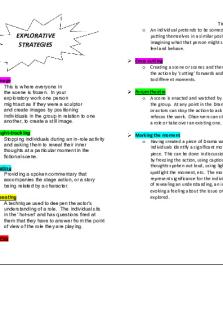Introduction DRAMA DOCX

| Title | Introduction DRAMA |
|---|---|
| Author | Indrawaty Arifuddin |
| Pages | 13 |
| File Size | 36.2 KB |
| File Type | DOCX |
| Total Downloads | 334 |
| Total Views | 463 |
Summary
Introduction Drama as a literary genre is realized in performance, which is why Robert Di Yanni (quoted in Dukore) describes it as “staged art” (867). As a literary form, it is designed for the theatre because characters are assigned roles and they act out their roles as the action is enacted on sta...
Description
Introduction Drama as a literary genre is realized in performance, which is why Robert Di Yanni (quoted in Dukore) describes it as "staged art" (867). As a literary form, it is designed for the theatre because characters are assigned roles and they act out their roles as the action is enacted on stage. These characters can be human beings, dead or spiritual beings, animals, or abstract qualities. Drama is an adaptation, recreation and reflection of reality on stage. Generally, the word, dramatist is used for any artist who is involved in any dramatic composition either in writing or in performance. Drama is different from other genres of literature. It has unique characteristics that have come about in response to its peculiar nature. Really, it is difficult to separate drama from performance because during the stage performance of a play, drama brings life experiences realistically to the audience. It is the most concrete of all genres of literature. When you are reading a novel, you read a story as told by the novelist. The poem's message in most cases is not direct because it is presented in a compact form or in a condensed language. The playwright does not tell the story instead you get the story as the characters interact and live out their experiences on stage. In drama, the characters/actors talk to themselves and react to issues according to the impulse of the moment. Drama is therefore presented in dialogue. Evolution of drama bears a rich history and it had influences mainly from the Western countries. The theatrical culture emerged from Greece and Athens, thereby creating an impact throughout the world. Classical Athenian drama was succeeded by Roman drama, Medieval, Elizabethan and Jacobean (English renaissance theater), modern and postmodern drama. Different genres of dramas were produced, which gained immense popularity amongst all sections of the society. Worth to note, Asian countries like India, China and Japan also composed dramas that explicitly symbolized their tradition, culture and ethnicity. 1...
Similar Free PDFs

Introduction DRAMA
- 13 Pages

DRAMA
- 40 Pages

Drama adrama too long drama
- 1 Pages

Makalah drama
- 10 Pages

NASKAH DRAMA
- 11 Pages

Elizabethan Drama
- 5 Pages

Drama Pendidikan
- 5 Pages

Naskah drama
- 4 Pages

Drama Triangle - appunti
- 5 Pages

APRESIASI PENGAJARAN DRAMA
- 24 Pages

Skrip Drama TERJEBAK
- 8 Pages

7 Vl Drama - Mitschriften
- 13 Pages

TOKOH DRAMA LAMA
- 25 Pages

Drama komunikasi dan konseling
- 13 Pages

Explorative Strategies in Drama
- 2 Pages
Popular Institutions
- Tinajero National High School - Annex
- Politeknik Caltex Riau
- Yokohama City University
- SGT University
- University of Al-Qadisiyah
- Divine Word College of Vigan
- Techniek College Rotterdam
- Universidade de Santiago
- Universiti Teknologi MARA Cawangan Johor Kampus Pasir Gudang
- Poltekkes Kemenkes Yogyakarta
- Baguio City National High School
- Colegio san marcos
- preparatoria uno
- Centro de Bachillerato Tecnológico Industrial y de Servicios No. 107
- Dalian Maritime University
- Quang Trung Secondary School
- Colegio Tecnológico en Informática
- Corporación Regional de Educación Superior
- Grupo CEDVA
- Dar Al Uloom University
- Centro de Estudios Preuniversitarios de la Universidad Nacional de Ingeniería
- 上智大学
- Aakash International School, Nuna Majara
- San Felipe Neri Catholic School
- Kang Chiao International School - New Taipei City
- Misamis Occidental National High School
- Institución Educativa Escuela Normal Juan Ladrilleros
- Kolehiyo ng Pantukan
- Batanes State College
- Instituto Continental
- Sekolah Menengah Kejuruan Kesehatan Kaltara (Tarakan)
- Colegio de La Inmaculada Concepcion - Cebu
